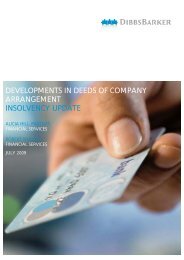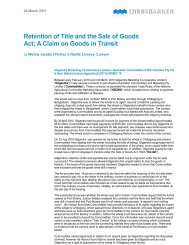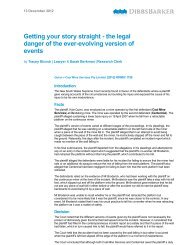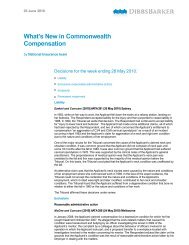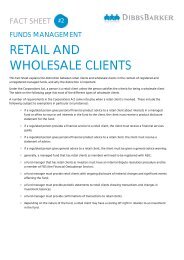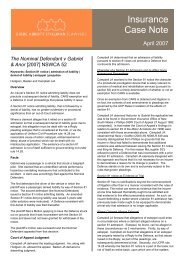Copyright In The Plans For Project Homes. A Fine Line Between ...
Copyright In The Plans For Project Homes. A Fine Line Between ...
Copyright In The Plans For Project Homes. A Fine Line Between ...
You also want an ePaper? Increase the reach of your titles
YUMPU automatically turns print PDFs into web optimized ePapers that Google loves.
22 OCTOBER 2008<br />
<strong>Copyright</strong> <strong>In</strong> <strong>The</strong> <strong>Plans</strong> <strong>For</strong> <strong>Project</strong><br />
<strong>Homes</strong>. A <strong>Fine</strong> <strong>Line</strong> <strong>Between</strong><br />
Functionality And Originality<br />
Dibbs Abbott Stillman Lawyers restructured on 1 March, 2009.<br />
<strong>The</strong> Sydney, Brisbane and Canberra offices are now DibbsBarker.<br />
<strong>The</strong> competitive nature of the project homes market can make it difficult for developers to market and sell a project home that<br />
both meets the functional needs of potential customers, as well as offering some individuality and originality. A number of<br />
recent Federal Court decisions have highlighted the complicated relationship between project home designs and copyright<br />
law. <strong>The</strong>se cases include Barrett Property Group Pty Limited v Metricon <strong>Homes</strong> Pty Limited (2007) 74 IPR 52, Barrett<br />
Property Group Pty Limited v Carlisle <strong>Homes</strong> Pty Limited [2008] FCA 375, Metricon <strong>Homes</strong> Pty Limited v Barrett Property<br />
Group Pty Limited [2008] FCAFC 46 and <strong>In</strong>form Design and Construction Pty Limited v Boutique <strong>Homes</strong> Melbourne Pty<br />
Limited [2008] FCA 912.<br />
<strong>The</strong> intention of this article is not to specifically review these cases but instead consider the common issues that arise when<br />
attempting to protect the copyright in the design of a project home.<br />
Subsistence of copyright in project home designs<br />
A drawing constituting a design for a project home is protected under the <strong>Copyright</strong> Act 1968 (the Act) as an artistic work.<br />
<strong>The</strong> copyright owner has the exclusive right to reproduce the work, or a substantial part of the work, in a material form. Under<br />
s21(3) of the Act, an artistic work shall be deemed to have been reproduced if a two dimensional drawing is reproduced in<br />
three dimensional form, or vice versa.<br />
It is a reproduction of the copyright in a drawing for a design of a home (the Original Design) to either build a home by<br />
reference to:<br />
the Original Design, or a substantial part of the Original Design; or<br />
a home, or a substantial part of a home, that has been built based upon the Original Design.<br />
If either of these are done without the permission of the owner of the copyright in the Original Design, it is an infringement of<br />
the copyright in the Original Design and is a breach of the Act.<br />
Perhaps the best summary of the difficulties that can arise in relation to copyright in project home designs was set out in<br />
Tamawood Limited v Henley Arch Pty Limited (2004) 61 IPR 378. This case noted that all modern homes have certain<br />
features in common and in the case of project homes, there are pressures towards sameness. <strong>The</strong>re are also certain<br />
functional elements often common to all homes, such as the desire to place the dining room close to the kitchen, an en suite<br />
bathroom in the main bedroom and at least one bathroom in proximity to the other bedrooms. <strong>The</strong> design of a project home,
therefore, requires a mixture of commonplace features with labour, skill, judgement and, as a result, some originality.<br />
<strong>The</strong> more simple, commonplace and straightforward the subject matter of a copyright work, the closer the similarity required if<br />
infringement of that copyright is to be found.<br />
Protection under the Act also not only applies to the design as a whole, but to substantial parts of that design. <strong>The</strong> question<br />
as to what is a substantial part is a question of fact and degree but is also decided by its quality rather than its quantity. Even<br />
if, therefore, only a small part of the design is copied, that part could be an essential part from a qualitative sense and still<br />
amount to an infringement of copyright. <strong>In</strong> Tamawood, the Court asked whether the part or parts taken represented a<br />
substantial part of the labour, skill and judgement of the author that made the whole work original.<br />
<strong>The</strong> dividing line between that which is dictated by broad functional requirements and that which is not, is, however, often<br />
unclear.<br />
Recent cases<br />
Recent cases illustrate the types of issues that arise.<br />
<strong>In</strong>form Design failed in its case against Boutique <strong>Homes</strong>. This case was concerned with the positioning of the staircase and<br />
the location of the wet services surrounding it. This concept made good economic sense and was adopted by both <strong>In</strong>form<br />
Design and Boutique <strong>Homes</strong>. <strong>In</strong>form Design claimed Boutique <strong>Homes</strong> had copied its design. Boutique <strong>Homes</strong> was, however,<br />
able to produce a detailed documentary trail demonstrating how it had come to independently create its own design over<br />
several months and with hundreds of changes based upon trial and error. <strong>The</strong> independent creation of a work that is the<br />
same, or substantially similar, to that created by another does not amount to copyright infringement.<br />
Barrett was successful in its disputes with both Metricon and Carlisle <strong>Homes</strong>. Central to these disputes was an “alfresco<br />
quadrant” feature which formed part of Barrett’s designs. Both cases noted that Barrett had invested significant amounts of<br />
labour, skill and judgement in the development of the plans for its houses with the alfresco quadrant. <strong>In</strong> fact it was the<br />
alfresco quadrant that was the distinctive and essential feature of Barrett’s designs. This feature was copied by both<br />
Metricon and Carlisle <strong>Homes</strong>. <strong>The</strong> alfresco quadrant formed a substantial part of Barrett’s designs and was more than just a<br />
commonplace design. Barrett was able to produce documentary evidence to demonstrate that the alfresco quadrant was the<br />
product of considerable design evolution.<br />
<strong>In</strong> relation to one of its project homes, Barrett was able to produce approximately 130 drawings and notes that culminated in<br />
the final plan and the development of the alfresco feature. Far from being trivial, this design feature had not appeared in the<br />
market before and formed a key part of a commercially very successful design.<br />
Lessons for project home designers<br />
Designers should be aware of the fine line that exists between a home consisting of purely common features driven by<br />
functionality and the original features that make a project home stand out from the crowd. If a designer has invested<br />
significant time, skill or judgement in designing the original part, then any argument that that part is a merely trivial part of the<br />
design may not stand up in a court.<br />
It is important to keep records of all designs to demonstrate how they came about. A document trail showing how a design<br />
came about can help support an argument that a particular feature is far from functional and is, in fact, an essential, original<br />
part of the design from a qualitative point of view (as per the Barrett cases). <strong>In</strong> other words, a great deal of thought went into<br />
creating that particular part of the design and it warrants copyright protection.<br />
Another reason for keeping a document trail is to assist (as it did Boutique <strong>Homes</strong>) with the defence of any accusations of<br />
copying. <strong>The</strong> document trail could demonstrate evidence that a design was developed independently and it was just a matter<br />
of chance that it turned out identical or similar to the design of another.<br />
<strong>The</strong> often functional nature of project home design can make it difficult to develop and protect truly original ideas. <strong>The</strong><br />
competitive nature of the industry and the fine line between functionality and originality lends itself to designers potentially<br />
crossing the line between what they can copy and what they cannot copy. <strong>The</strong> suggestions in this article may help designers
emain on the right side of copyright laws.<br />
Michael Sutton, Senior Associate<br />
IP & Technology Group<br />
E: michael.sutton@dibbsbarker.com



